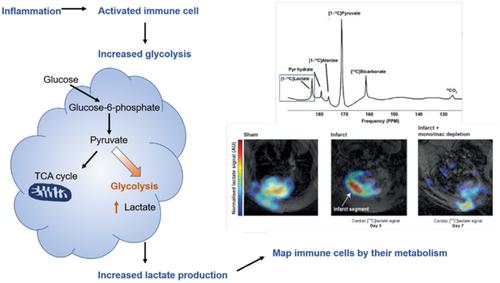当前位置:
X-MOL 学术
›
NMR Biomed.
›
论文详情
Our official English website, www.x-mol.net, welcomes your
feedback! (Note: you will need to create a separate account there.)
Hyperpolarized 13C magnetic resonance imaging for noninvasive assessment of tissue inflammation
NMR in Biomedicine ( IF 2.7 ) Pub Date : 2020-12-08 , DOI: 10.1002/nbm.4460 Stephanie Anderson 1 , James T Grist 1, 2, 3 , Andrew Lewis 1, 2 , Damian J Tyler 1, 2
NMR in Biomedicine ( IF 2.7 ) Pub Date : 2020-12-08 , DOI: 10.1002/nbm.4460 Stephanie Anderson 1 , James T Grist 1, 2, 3 , Andrew Lewis 1, 2 , Damian J Tyler 1, 2
Affiliation

|
Inflammation is a central mechanism underlying numerous diseases and incorporates multiple known and potential future therapeutic targets. However, progress in developing novel immunomodulatory therapies has been slowed by a need for improvement in noninvasive biomarkers to accurately monitor the initiation, development and resolution of immune responses as well as their response to therapies. Hyperpolarized magnetic resonance imaging (MRI) is an emerging molecular imaging technique with the potential to assess immune cell responses by exploiting characteristic metabolic reprogramming in activated immune cells to support their function. Using specific metabolic tracers, hyperpolarized MRI can be used to produce detailed images of tissues producing lactate, a key metabolic signature in activated immune cells. This method has the potential to further our understanding of inflammatory processes across different diseases in human subjects as well as in preclinical models. This review discusses the application of hyperpolarized MRI to the imaging of inflammation, as well as the progress made towards the clinical translation of this emerging technique.
中文翻译:

超极化 13C 磁共振成像用于组织炎症的无创评估
炎症是许多疾病的核心机制,包含多个已知和潜在的未来治疗靶点。然而,由于需要改进非侵入性生物标志物以准确监测免疫反应的启动、发展和解决以及它们对治疗的反应,开发新型免疫调节疗法的进展已经放缓。超极化磁共振成像 (MRI) 是一种新兴的分子成像技术,具有通过利用激活的免疫细胞中特征性代谢重编程来支持其功能来评估免疫细胞反应的潜力。使用特定的代谢示踪剂,超极化 MRI 可用于生成产生乳酸的组织的详细图像,乳酸是激活的免疫细胞的关键代谢特征。这种方法有可能进一步了解人类受试者以及临床前模型中不同疾病的炎症过程。这篇综述讨论了超极化 MRI 在炎症成像中的应用,以及这种新兴技术的临床转化所取得的进展。
更新日期:2021-02-04
中文翻译:

超极化 13C 磁共振成像用于组织炎症的无创评估
炎症是许多疾病的核心机制,包含多个已知和潜在的未来治疗靶点。然而,由于需要改进非侵入性生物标志物以准确监测免疫反应的启动、发展和解决以及它们对治疗的反应,开发新型免疫调节疗法的进展已经放缓。超极化磁共振成像 (MRI) 是一种新兴的分子成像技术,具有通过利用激活的免疫细胞中特征性代谢重编程来支持其功能来评估免疫细胞反应的潜力。使用特定的代谢示踪剂,超极化 MRI 可用于生成产生乳酸的组织的详细图像,乳酸是激活的免疫细胞的关键代谢特征。这种方法有可能进一步了解人类受试者以及临床前模型中不同疾病的炎症过程。这篇综述讨论了超极化 MRI 在炎症成像中的应用,以及这种新兴技术的临床转化所取得的进展。









































 京公网安备 11010802027423号
京公网安备 11010802027423号